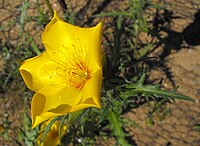
Residence time, native range size, and genome size predict naturalization among angiosperms introduced to Australia
Sign Up to like & getrecommendations! Published in 2017 at "Ecology and Evolution"
DOI: 10.1002/ece3.3505
Abstract: Abstract Although critical to progress in understanding (i) if, and (ii) at what rate, introduced plants will naturalize and potentially become invasive, establishing causal links between traits and invasion success is complicated by data gaps,… read more here.
Keywords: naturalization; size; native range; residence time ... See more keywords

Widespread hybridization in the introduced hog deer population of Victoria, Australia, and its implications for conservation
Sign Up to like & getrecommendations! Published in 2019 at "Ecology and Evolution"
DOI: 10.1002/ece3.5603
Abstract: Abstract In Australia, many species have been introduced that have since undergone drastic declines in their native range. One species of note is the hog deer (Axis porcinus) which was introduced in the 1860s to… read more here.
Keywords: deer population; hog deer; population; native range ... See more keywords

Escape from natural enemies depends on the enemies, the invader, and competition
Sign Up to like & getrecommendations! Published in 2020 at "Ecology and Evolution"
DOI: 10.1002/ece3.6737
Abstract: Abstract The enemy release hypothesis (ERH) attributes the success of some exotic plant species to reduced top‐down effects of natural enemies in the non‐native range relative to the native range. Many studies have tested this… read more here.
Keywords: canadensis; non native; competition; native range ... See more keywords

Ecological and environmental context shape the differential effects of a facilitator in its native and invaded ranges.
Sign Up to like & getrecommendations! Published in 2021 at "Ecology"
DOI: 10.1002/ecy.3478
Abstract: Invasive species often exhibit disproportionately strong negative effects in their introduced range compared to their native range, and much research has been devoted to understanding the role of shared evolutionary history, or lack thereof, in… read more here.
Keywords: range; native range; shared evolutionary; algal cover ... See more keywords

Of mutualism and migration: will interactions with novel ericoid mycorrhizal communities help or hinder northward Rhododendron range shifts?
Sign Up to like & getrecommendations! Published in 2022 at "Oecologia"
DOI: 10.1007/s00442-021-05081-9
Abstract: Rapid climate change imperils many small-ranged endemic species as the climate envelopes of their native ranges shift poleward. In addition to abiotic changes, biotic interactions are expected to play a critical role in plant species’… read more here.
Keywords: native range; ericoid mycorrhizal; rhododendron; migration ... See more keywords

Disentangling the genetic origin of Heracleum persicum (Apiaceae) in Europe: multiple introductions from multiple source populations
Sign Up to like & getrecommendations! Published in 2021 at "Biological Invasions"
DOI: 10.1007/s10530-021-02618-0
Abstract: Unraveling the origin and colonization history of invasive plants is a long-standing challenge in evolutionary and conservation biology. The knowledge of the origin of the invasive plants in Europe is often confounded by limited sampling… read more here.
Keywords: range; source; heracleum persicum; native range ... See more keywords

Genetic variability of Anthoxanthum aristatum Boiss. (Poaceae) at the non-native range limit
Sign Up to like & getrecommendations! Published in 2019 at "Genetic Resources and Crop Evolution"
DOI: 10.1007/s10722-019-00850-1
Abstract: Anthoxanthum aristatum Boiss. is native to southern and western Europe and North Africa. In Central Europe this species is recognized as invasive. Its ability to colonize various habitats may result from a high level of… read more here.
Keywords: range limit; native range; non native; anthoxanthum aristatum ... See more keywords

First genetically verified occurrence of Ligula pavlovskii outside its native range and characteristics of its infection in Neogobius fluviatilis
Sign Up to like & getrecommendations! Published in 2020 at "Journal of Great Lakes Research"
DOI: 10.1016/j.jglr.2020.10.008
Abstract: Abstract In this study, we provide the first genetically verified distribution record beyond its native range of Ligula pavlovskii, a high-impact endoparasite of Ponto-Caspian gobies. According to parasitological surveys, ligulosis was detected for the first… read more here.
Keywords: first genetically; range; genetically verified; native range ... See more keywords

Chloroplast DNA analysis of the invasive weed, Himalayan balsam (Impatiens glandulifera), in the British Isles
Sign Up to like & getrecommendations! Published in 2020 at "Scientific Reports"
DOI: 10.1038/s41598-020-67871-0
Abstract: Impatiens glandulifera or Himalayan balsam (HB), is an invasive alien weed throughout the British Isles (BI). Classical biological control of HB in the BI using a rust fungus from the Himalayan native range was implemented… read more here.
Keywords: range; impatiens glandulifera; british isles; himalayan balsam ... See more keywords

Invasive Widow Spiders Perform Differently At Low Temperatures than Conspecifics from the Native Range.
Sign Up to like & getrecommendations! Published in 2022 at "Integrative and comparative biology"
DOI: 10.1093/icb/icac073
Abstract: Temperature challenges are one of the leading abiotic causes of success or failure of non-native species in a novel environment, and this is particularly true for low temperatures. Establishing and reproducing in a novel thermal… read more here.
Keywords: native range; success; low temperatures; native population ... See more keywords

Historical legacies and ecological determinants of grass naturalizations worldwide
Sign Up to like & getrecommendations! Published in 2020 at "Ecography"
DOI: 10.1111/ecog.04609
Abstract: The global distribution of exotic species is the result of abiotic, biotic and dispersal filtering processes that shape the movement and success of species outside their native range. In this study we aim to understand… read more here.
Keywords: grass; outside native; grass species; native range ... See more keywords